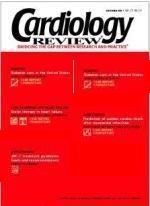Publication
Article
Cardiology Review® Online
BNP for the diagnosis of heart failure: A valuable tool, but no silver bullet
B-type natriuretic peptide (BNP) is a 32-amino acid protein secreted primarily by the cardiac ventricles in response to increased intraventricular pressure.1 Physiologically, BNP functions as a counterregulatory hormone that opposes the effects of angiotensin II, norepinephrine, and endothelin, thus promoting vasodilation and natriuresis. BNP levels are increased in patients with acute or chronic heart failure, and the magnitude of BNP elevation correlates moderately with the left ventricular end diastolic pressure and symptom severity (eg, New York Heart Association class).2,3 In addition, BNP levels can be measured rapidly and relatively inexpensively (less than $50) using point-of-care devices approved by the Food and Drug Administration. As a result, BNP has achieved widespread acceptance as a valuable new tool to aid in the diagnosis of heart failure and, in particular, to distinguish dyspnea due to heart failure from that attributable to other causes (eg, lung disease). In the Breathing Not Properly Study, for example, BNP was found to be more accurate than all other clinical and laboratory findings in identifying heart failure among 744 patients presenting to the emergency department with dyspnea.4
Despite the prevalent enthusiasm for BNP, both as a diagnostic tool and as an aid in managing heart failure patients, it must be recognized that it is not a perfect test. In the Breathing Not Properly Study, a BNP cutpoint of 100 pg/mL was associated with a 90% sensitivity, 76% specificity, and 83% overall
predictive accuracy for diagnosing heart failure.4 This means that 10% of patients with acute heart failure had a normal BNP level, 24% of patients without acute heart failure had an elevated BNP level, and BNP was “wrong” in 1 of 6 patients (17%) presenting with worsening shortness of breath. It is thus evident that although BNP is a useful test, it must be interpreted in the context of other available data (ie, history, physical examination, chest x-ray, etc), and it should not be presumed that a normal BNP value excludes heart failure, nor that an elevated BNP value is “diagnostic” of heart failure.
Tang and Francis (page 41) provide additional evidence indicating that BNP levels should not be considered the new “gold standard” for diagnosis of heart failure, particularly in the outpatient setting. In their study of 449 ambulatory patients with symptomatic (NYHA class II-III) systolic heart failure, 106 (23.6%) had “normal” BNP levels (< 100 pg/mL). Moreover, among 109 patients with asymptomatic left ventricular systolic dysfunction, well over half had normal BNP levels. The authors conclude that it is essential to consider the clinical context when interpreting the results of
BNP testing.
Although not discussed by Tang and Francis in their article, Bayes’ theorem provides some guidance on how to interpret the results of any less-than-perfect diagnostic test (of which BNP is a clear example).5
According to Bayes’ theorem, the predictive value of any such test is largely dependent on the pretest likelihood of having the disease. Thus, an elevated BNP level in a patient with a high likelihood of having heart failure (eg, a patient with an ejection fraction of 20% and a chest x-ray showing pulmonary edema) is almost certainly a “true positive,” ie, the positive predictive value in such patients approaches 100%, whereas a “negative” test in the same patient should be regarded as a probable “false negative.” Similarly, in a patient with a low pretest probability of having heart failure (eg, a young asthmatic patient with active wheezing), a positive test is likely to represent a false positive, whereas a negative test is very likely to be a true negative. Note that a clinically important implication of Bayes’ theorem is that a diagnostic test such as BNP is most helpful in patients with an intermediate likelihood of having the disease (eg, patients with dyspnea of uncertain cause and nondiagnostic findings from other tests). It also follows that patients with classic pulmonary edema do not need a BNP to confirm a diagnosis of heart failure, nor do most patients with severe lung disease and a previously normal cardiac evaluation require a BNP to rule out heart failure.
Given what is known about the physiology of BNP, how can we account for the fact that nearly one fourth of patients with symptomatic heart failure in the report by Tang and Francis had “normal” BNP levels? The authors propose several possible mechanisms. First, and perhaps most likely, patients with normal BNP levels may simply have been “well-compensated,” with essentially normal left ventricular diastolic pressures at rest. Such patients might still be symptomatic with activity, due to an increase in left ventricular pressure with exertion, but infrequent and transient elevations of left ventricular pressure may not be sufficient to increase the BNP level above the normal range. Alternatively, BNP levels may be dependent on multiple factors beyond left ventricular pressure. Indeed, the authors found that younger age, better cardiac and renal function, and nonischemic etiology of heart failure were predictive of normal BNP in their population. In addition, genetic factors could influence the synthesis, bioactivity, metabolism, and clearance of BNP.6
An important limitation of the study by Tang and Francis is that the population was relatively young (mean age 59 years), predominantly male (71%), and restricted to patients with impaired left ventricular systolic function. In contrast, the median age of heart failure patients in the community is about 75 years, approximately half are women, and up to 50% have preserved left ventricular systolic function.7 Moreover, BNP levels are known to increase with age, they tend to be higher in women than in men (especially among the elderly),8 and although BNP levels are generally increased in patients with heart failure and preserved systolic function,9 the magnitude of elevation tends to be less than in patients with systolic heart failure.10 In light of these factors, the sensitivity and specificity of BNP for diagnosing heart failure decline with age,8 as a result of which both the false-positive and false-negative rates increase with age, thus mandating an even more cautious approach to the interpretation of BNP levels in elderly patients with suspected heart failure.
In summary, the study by Tang and Francis confirms what most clinicians already know—there are very few silver bullets in the practice of medicine, and although our diagnostic tools continue to improve, there is still a pivotal role for good, sound clinical judgment.






